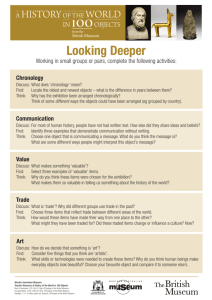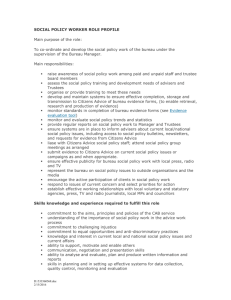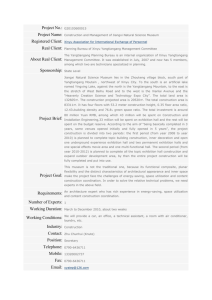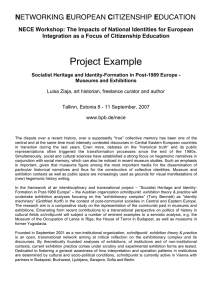7 March 2011 Project aiming at the foundation of a H E
advertisement
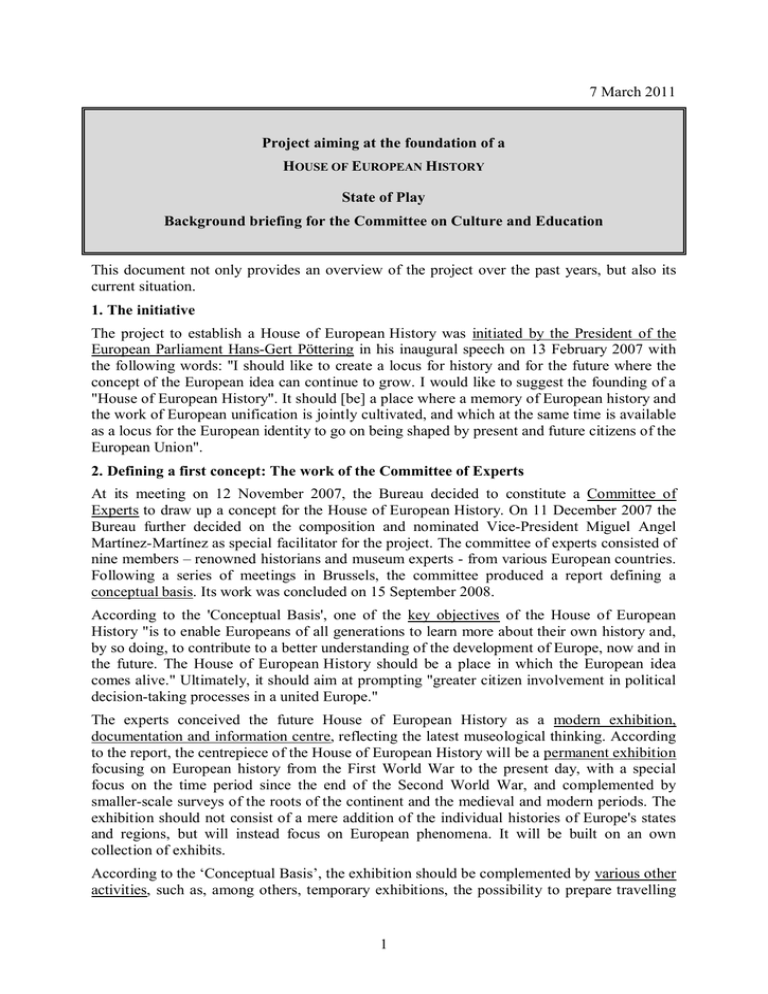
7 March 2011 Project aiming at the foundation of a HOUSE OF EUROPEAN HISTORY State of Play Background briefing for the Committee on Culture and Education This document not only provides an overview of the project over the past years, but also its current situation. 1. The initiative The project to establish a House of European History was initiated by the President of the European Parliament Hans-Gert Pöttering in his inaugural speech on 13 February 2007 with the following words: ''I should like to create a locus for history and for the future where the concept of the European idea can continue to grow. I would like to suggest the founding of a "House of European History". It should [be] a place where a memory of European history and the work of European unification is jointly cultivated, and which at the same time is available as a locus for the European identity to go on being shaped by present and future citizens of the European Union". 2. Defining a first concept: The work of the Committee of Experts At its meeting on 12 November 2007, the Bureau decided to constitute a Committee of Experts to draw up a concept for the House of European History. On 11 December 2007 the Bureau further decided on the composition and nominated Vice-President Miguel Angel Martínez-Martínez as special facilitator for the project. The committee of experts consisted of nine members – renowned historians and museum experts - from various European countries. Following a series of meetings in Brussels, the committee produced a report defining a conceptual basis. Its work was concluded on 15 September 2008. According to the 'Conceptual Basis', one of the key objectives of the House of European History "is to enable Europeans of all generations to learn more about their own history and, by so doing, to contribute to a better understanding of the development of Europe, now and in the future. The House of European History should be a place in which the European idea comes alive." Ultimately, it should aim at prompting "greater citizen involvement in political decision-taking processes in a united Europe." The experts conceived the future House of European History as a modern exhibition, documentation and information centre, reflecting the latest museological thinking. According to the report, the centrepiece of the House of European History will be a permanent exhibition focusing on European history from the First World War to the present day, with a special focus on the time period since the end of the Second World War, and complemented by smaller-scale surveys of the roots of the continent and the medieval and modern periods. The exhibition should not consist of a mere addition of the individual histories of Europe's states and regions, but will instead focus on European phenomena. It will be built on an own collection of exhibits. According to the ‘Conceptual Basis’, the exhibition should be complemented by various other activities, such as, among others, temporary exhibitions, the possibility to prepare travelling 1 exhibitions, and, last but not least, a broad offer of events, publications and pedagogical services for a wide range of visitors. 3. Approval of the ‘Conceptual Basis’ by the Parliament’s Bureau The concept paper was first presented to the Parliament’s Bureau on 19 November 2008. It was also presented to and approved by the Committee on Culture and Education on 15 December 2008. Later the same day, the Parliament's Bureau approved the conceptual basis for the establishment of the House of European History and decided to start the preparatory work for its realisation. At the same meeting, the Bureau further invited the President to submit proposals for the setting-up of a supervisory board and for a high-level academic committee. The Bureau also approved the setting up of a start-up team. 4. Setting-up of a supervisory structure Subsequently, a Board of Trustees and an Academic Committee were set up. Their composition was unanimously approved by the Bureau at its meeting of 18 February 2009. Former President of the European Parliament Hans-Gert Pöttering, MEP is Chair of the Board of Trustees, while Vice-President Miguel Angel Martínez-Martínez is the Vice-Chair. The Academic Committee is chaired by Włodimierz Borodziej, Professor of History at the University of Warsaw. The Committee on Culture and Education is represented on the Board of Trustees by its Chair and another Member. The Committee on Budgets is equally represented by its Chair. The Commissioner for Culture and Education is also a member of the Board of Trustees. Both bodies held their constituent meetings on 5 May 2009 in Strasbourg. On 14 September 2009, the Bureau decided to set up a Contact Group chaired by VicePresident Martínez-Martínez and further composed of Vice-Presidents Pittella, KratsaTsagaropoulou, Vidal-Quadras, Durant and Angelilli. On a daily basis, a coordination team, led by Harald Rømer, former Secretary-General of the EP, supervises the project's progress. This coordination team inter alia prepares the meetings of the various bodies of the House of European History, is involved in the architectural competition and in the Academic Team. 5. Assigning and transforming the Eastman Building On 17 June 2009, the Parliament's Bureau approved the allocation of the Eastman Building to the House of European History. This Building had recently been acquired by the Parliament through a long-term lease of 99 years. With a view to transforming this former dental clinic and current office building into an exhibition building, an architectural competition was published by the Parliament’s Directorate-General for Infrastructure and Logistics (DG INLO) on 21 July 2009, following discussions in and guidelines from the Working Group on Buildings, Transport and Green Parliament. Following the publication of the architectural competition, twenty-six valid expressions of interest were received. These expressions of interest were examined by an evaluation committee, which finished its work in January 2010. The evaluation was conducted on the basis of a quantification of the elements mentioned in the publication of the notice in the Official Journal and the components provided in the Conceptual Basis. As a result of this examination, twelve candidates were retained and were asked to prepare a preliminary design. In September 2010, an international jury examined the projects and retained two projects. The evaluation of the two remaining proposals has resulted in a definitive choice. In early March 2 2011, the Directorate-General for Infrastructure and Logistics (DG INLO), has formally confirmed this choice. However, the contract with the architect can only be signed following the transfer from the reserve of EUR 2,5 million (budgetline "fitting-out premises: Brussels") by the Committee on Budgets which will re-discuss the issue on 15 March 2011. The Bureau is informed at its meeting on 7 March 2011. 6. The Academic Project Team The Academic Project Team took up work on 1 January 2011. The team is led by Mrs Taja Vovk van Gaal, who has a long experience as a Director of the City Museum in Ljubljana and an outstanding knowledge of the European museum landscape and its most innovative museums through her long-standing activity as judge for the European Museum of the Year Award. The international, interdisciplinary Academic Project Team is composed of museum professionals and historians from all over Europe. Since January 2011, the Academic Project Team has been working on a first set of basic documents defining the exhibition and collecting data for the House of European History, the mission and the vision, as well as a first museological concept for the exhibition. The Academic Project Team will be assisted by the Academic Committee of the House of European History, which will also oversee the academic independence of the project. In the coming weeks, the Academic Project Team will work on the content of the permanent exhibition. The input of museum professionals has also been essential for the draft budget for the creation of the exhibitions of the House of European History. 7. Budget An overview of budget requirements has been submitted to the Committee on Budgets. A total amount of EUR 31million will be required for the renovation and extension of the Eastman building. This amount includes works, technical studies, architect's fees and improvements requested following the evaluation of the architectural proposals by the Jury. For the fitting-out of the HEH a total amount of EUR 21,4 million is required, based on a price of EUR 2.200/ m2 for the fitting out of the exhibitions which is an average for this type of exhibitions. The said amount also includes the refurbishment of the other areas of the Eastman building and the adaptation of the exhibition in order to respect the multilingual guidelines. Running costs for the future museum are currently being calculated. Annex: List of the Members of the Board of Trustees and of the Academic Committee 3 Annex 1 HOUSE OF EUROPEAN HISTORY Members of the Board of Trustees and of the Academic Committee BOARD OF TRUSTEES Mr Hans-Gert PÖTTERING Chairman Mr Miguel Angel MARTINEZ MARTINEZ Vice-Chairman Vicomte Etienne DAVIGNON Mr Gérard ONESTA Mr Charles PICQUÉ Prime Minister - Brussels Capital Region Mr Wojciech ROSZKOWSKI Mr Peter SUTHERLAND Ms Diana WALLIS Mr Francis WURTZ Ms Doris Gisela PACK Chairwoman, Committee on Culture and Education Ms Chrysoula PALIADELI Member, Committee on Culture and Education Mr Alain LAMASSOURE Chairman, Committee on Budgets Mrs Androulla VASSILIOU Commissioner for Education, Training and Culture 4 Mr Wlodzimierz BORODZIEJ, Chairman of the Academic Committee Mr Hans-Walter HÜTTER, Chairman of the former Committee of Experts 5 ACADEMIC COMMITTEE Mr Wlodzimierz BORODZIEJ Chairman Mr Hans-Walter HÜTTER Chairman of the former Committee of Experts Mr Giorgio CRACCO Mr Norman DAVIES Mr Matti KLINGE Ms Anita MEINARTE Ms Hélène MIARD-DELACROIX Ms Mary MICHAILIDOU Mr Oliver RATHKOLB Mr Antonio REIS Ms Maria SCHMIDT Mr Jean-Pierre VERDIER Mr Henk WESSELING 6
